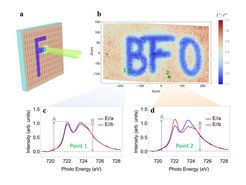Control of Bistable Antiferromagnetic States for Spintronics
Two bistable and reversibly controllable antiferromagnetic states in strained BiFeO3 (BFO) films are discovered. These two non-volatile antiferromagnetic states are successfully patterned with a non-contact approach combining both optical and magnetic methods. The written antiferromagnetic pattern is electrically readable with at least 30% signal difference. This work promises an efficient route toward practical applications of antiferromagnetic spintronics.
Nowadays spintronic devices for magnetic memory and information processing are mainly based on the bistability of ordered spin states in ferromagnets. The use of ferromagnetic units, however, sets in a bottleneck for high-density memory integration and information retention due to its ferromagnetic stray field from the neighbors and its vulnerability to the magnetic field perturbations, respectively. All these could be changed and improved by replacing ferromagnets with antiferromagnets as the units. Moreover, the switching speed attainable in antiferromagnets is expected to far exceed those of ferromagnets. This arises one of the most emerging fields both in research and technology, namely, Antiferromagnetic Spintronics. The implantations of antiferromagnetic units require manipulatable and non-volatile antiferromagnetic bistable states at ambient temperature, however, those states are rarely reported in materials. Furthermore, the insensibility or even invisibility of antiferromagnetic character (i.e. zero net magnetic moment) to external stimuli poses great challenges in controlling and detecting antiferromagnetic states.
Scientists from the MPI CPfS, in collaboration with colleagues from National Yang Ming Chiao Tung University, National Cheng Kung University, and National Synchrotron Radiation Research Center in Taiwan as well as from Hiroshima University in Japan make use of strained engineering on multiferroic BiFeO3 (BFO) thin films, and fabricate the bistable antiferromagnetic states at room temperature for the first time. These two antiferromagnetic states are non-volatile and very close to each other in energy, which are conclusively verified by using soft x-ray linear dichroism spectroscopy as shown in the figure. Moreover, these two non-volatile antiferromagnetic states can be reversibly switched by a moderate magnetic field and a non-contact optical approach. Importantly, the conductivity of the two antiferromagnetic domains is drastically different. As demonstrated in this study, scientists have successfully realized an effective optical approach to write in and an electrical manner to read out the antiferromagnetic information in the strained BiFeO3 thin film, which makes this multiferroic system a potent candidate to multi-functional antiferromagnetic spintronic devices.

The electrical conductivity of the written area “BFO” is 30% higher than the unwritten area as shown in the teaser image.












